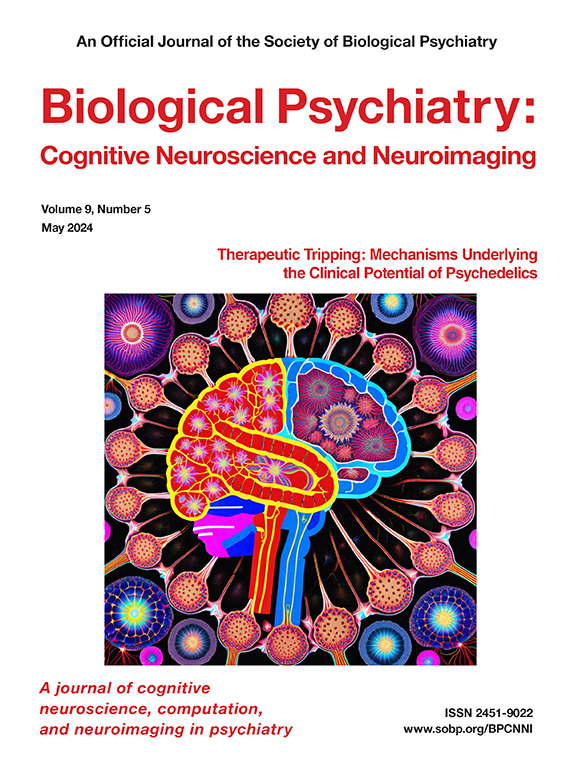Aperiodic (1/f) Neural Activity Robustly Tracks Symptom Severity Changes in Treatment-Resistant Depression
IF 5.7
2区 医学
Q1 NEUROSCIENCES
Biological Psychiatry-Cognitive Neuroscience and Neuroimaging
Pub Date : 2025-02-01
DOI:10.1016/j.bpsc.2024.10.019
引用次数: 0
Abstract
Background
A reliable physiological biomarker for major depressive disorder is essential for developing and optimizing neuromodulatory treatment paradigms. In this study, we investigated a passive electrophysiologic biomarker that tracks changes in depressive symptom severity on the order of minutes to hours.
Methods
We analyzed brief recordings from intracranial electrodes implanted deep in the brain during a clinical trial of deep brain stimulation for treatment-resistant depression in 5 human participants (nfemale = 3, nmale = 2). This surgical setting allowed for precise temporal and spatial sensitivity in the ventromedial prefrontal cortex, a challenging area to measure. We focused on the aperiodic slope of the power spectral density, a metric that reflects the balance of activity across all frequency bands and may serve as a proxy for excitatory/inhibitory balance in the brain.
Results
Our findings demonstrated that shifts in aperiodic slope correlated with depression severity, with flatter (less negative) slopes indicating reduced depression severity. This significant correlation was observed in all 5 participants, particularly in the ventromedial prefrontal cortex.
Conclusions
This biomarker offers a new way to track patient responses to major depressive disorder treatment, thus paving the way for individualized therapies in both intracranial and noninvasive monitoring contexts.
非周期性(1/f)神经活动可有力追踪耐药性抑郁症的症状严重程度变化。
背景:重度抑郁症的可靠生理生物标志物对于开发和优化神经调节治疗范例至关重要。本研究调查了一种被动电生理生物标志物,它能追踪抑郁症状严重程度在数分钟至数小时内的变化:我们分析了 5 名受试者(女性 3 人,男性 2 人)在接受脑深部刺激治疗耐药抑郁症的临床试验期间从植入大脑深部的颅内电极获得的简短记录。这种手术设置可以精确测量腹内侧前额叶皮层的时间和空间灵敏度,而这是一个具有挑战性的测量区域。我们重点研究了功率谱密度的非周期性斜率,该指标反映了所有频段的活动平衡,可作为大脑兴奋/抑制平衡的替代指标:我们的研究结果表明,非周期性斜率的变化与抑郁症的严重程度有关,斜率越平(负值越小)表明抑郁症的严重程度越低。在所有 5 名受试者中都观察到了这种明显的相关性,尤其是在腹内侧前额叶皮层:这种生物标志物为跟踪患者对重度抑郁障碍治疗的反应提供了一种新方法,为颅内和非侵入性监测背景下的个体化疗法铺平了道路。
本文章由计算机程序翻译,如有差异,请以英文原文为准。
求助全文
约1分钟内获得全文
求助全文
来源期刊

Biological Psychiatry-Cognitive Neuroscience and Neuroimaging
Neuroscience-Biological Psychiatry
CiteScore
10.40
自引率
1.70%
发文量
247
审稿时长
30 days
期刊介绍:
Biological Psychiatry: Cognitive Neuroscience and Neuroimaging is an official journal of the Society for Biological Psychiatry, whose purpose is to promote excellence in scientific research and education in fields that investigate the nature, causes, mechanisms, and treatments of disorders of thought, emotion, or behavior. In accord with this mission, this peer-reviewed, rapid-publication, international journal focuses on studies using the tools and constructs of cognitive neuroscience, including the full range of non-invasive neuroimaging and human extra- and intracranial physiological recording methodologies. It publishes both basic and clinical studies, including those that incorporate genetic data, pharmacological challenges, and computational modeling approaches. The journal publishes novel results of original research which represent an important new lead or significant impact on the field. Reviews and commentaries that focus on topics of current research and interest are also encouraged.
 求助内容:
求助内容: 应助结果提醒方式:
应助结果提醒方式:


